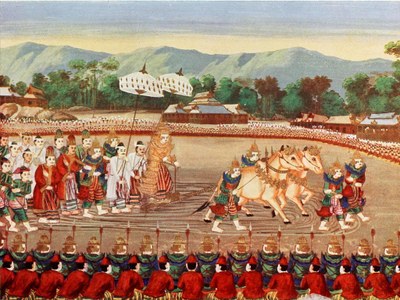Standards (Grades 9-10)
- Standard – CC.8.5.9-10.A
Cite specific textual evidence to support analysis of primary and secondary sources, attending to such features as the date and origin of the information. - Standard – CC.8.5.9-10.B
Determine the central ideas or information of a primary or secondary source; provide an accurate summary of how key events or ideas develop over the course of the text. - Standard – CC.8.5.9-10.I
Compare and contrast treatments of the same topic in several primary and secondary sources. - Standard – 8.4.9.A
Compare the role groups and individuals played in the social, political, cultural, and economic development throughout world history. - Standard – 8.4.9.B
Contrast the importance of historical documents, artifacts, and sites which are critical to world history. - Standard – 8.4.9.C
Analyze how continuity and change have impacted world history.
- Belief systems and religions
- Commerce and industry
- Technology
- Politics and government
- Physical and human geography
- Social organization
Standards (Grades 11-12)
- Standard – CC.8.5.11-12.A
Cite specific textual evidence to support analysis of primary and secondary sources, connecting insights gained from specific details to an understanding of the text as a whole. - Standard – CC.8.5.11-12.B
Determine the central ideas or information of a primary or secondary source; provide an accurate summary that makes clear the relationships among the key details and ideas. - Standard – CC.8.5.11-12.I
Integrate information from diverse sources, both primary and secondary, into a coherent understanding of an idea or event, noting discrepancies among sources. - Standard – 8.4.12.A
Evaluate the role groups and individuals played in the social, political, cultural, and economic development throughout world history. - Standard – 8.4.12.B
Evaluate the importance of historical documents, artifacts, and sites which are critical to world history. - Standard – 8.4.12.C
Evaluate how continuity and change have impacted the world today.
- Belief systems and religions
- Commerce and industry
- Technology
- Politics and government
- Physical and human geography
- Social organization
The BIG Idea
Myanmar’s national identity is made of its rich history of warrior kings who built and expanded their Buddhist Kingdoms. These kingdoms form the third pillar of Myanmar. On Day 1, students learned that rice farming and Buddhism make up the other two pillars.
Objective
- Identify major factors that define Burmese nationalism
- Recognize the vast role of Buddhism in Burmese history
Homework (to be done before class)
The questions following the articles below can either be assigned as written homework or discussed in class the following day. This lesson can be done over two days or modified as needed.
- Read Myanmar 101: Ancient Kings and Lost Empire. Myanmar’s different kingdoms are ruled by different people in different locations. Why do you think they are all categorized as Burmese kingdoms? What are the similarities and differences between these kingdoms? What sort of change do you see among these empires over time?
- Read pages 1-4 and 62-72 from The Glass Palace of the Kings of Burma. How is the power transferred from one king to another? What role does the king play in ancient Myanmar? What kind of power does the king have?
- Read We Were Kings: Burma’s Lost Royal Family. This article complements the optional video, The Last King of Myanmar. The article covers the transition from the age of kings to the age of British colonialism and subsequent military rule. How did the Burmese kingdoms end? Do you think Myanmar should give titles to the lost royals in its society as a way to preserve its history? Why?
Activity (in class)
- Watch Pagodas: The Ancient Burmese Status Symbols. Discuss the connection between the kings and the pagodas. What do the pagodas mean to the Burmese people?
- Small group brainstorming activity (can be done through creating a written list or verbal discussion): What is the role the Burmese kingdoms play in creating a Burmese identity?
- Class activity: Refer to the passage, “Society” in the encyclopedia entry, Konbaung Dynasty, and the Konbaung Dynasty Hierarchy Chart. Imagine that the students are members of Burmese society during the Konbaung dynasty (1752-1885). If the class is too large, split the students into two groups. Have the students assign roles amongst themselves or have students draw from a hat to help decide their roles (king, guards, scholars, queen, farmers, etc.) Give time for them to imagine what their chosen member would do in a day-to-day basis and have each student present their roles and their daily activities to the class in a few sentences.
Some depictions of the court and their members are below:

A depiction of the Royal Ploughing Ceremony by Saya Chone, a painter at the royal court.
Source: https://en.wikipedia.org/wiki/Konbaung_dynasty#/media/File:Saya_Chone%27s_%22Royal_Ploughing_Ceremony%22.png

Burmese court officials in 1795
An Attawoon (middle), or Minister of the Interior, and his wife (left) and a Seredogee, or Secretary of State (right) in their dress of ceremony.
Drawn by Singey Bey, engraved by T. Medland. – An account of an embassy to the kingdom of Ava, : sent by the Governor-General of India, in the year 1795, Plate 310. Author Michael Symes
Source: https://en.wikipedia.org/wiki/Konbaung_dynasty#/media/File:Burmese_Court_Officials_1795.jpg
Materials
Myanmar 101: Ancient Kings and Lost Empire
https://frontiermyanmar.net/en/myanmar-101-ancient-kings-and-lost-empires
The Glass Palace of the Kings of Burma (first two paragraphs of the introduction, pg. 1-4 and pg. 62-72)
http://www.burmalibrary.org/docs20/Glass_Palace_Chronicle_Of_The_Kings_Of_Burma.pdf
We Were Kings: Burma’s Lost Royal Family
https://web.archive.org/web/20221024174058/https://web.archive.org/web/20221024174058/https://web.archive.org/web/20221024174058/https://www.mmtimes.com/news/we-were-kings-burmas-lost-royal-family.html
Pagodas: The Ancient Burmese Status Symbols (video)
https://www.youtube.com/watch?v=yHwgS81QjNM
The Last King of Myanmar (optional video)
https://www.youtube.com/watch?v=NPJ2gJv54Zw
What is the Glass Palace Chronicle and why is it important? (optional video)
https://www.youtube.com/watch?v=CWb41ii3924
Konbaung Dynasty (encyclopedia entry)
http://www.newworldencyclopedia.org/entry/Konbaung_dynasty
Royal Ploughing Ceremony Photo by Saya Chone (photo)
https://en.wikipedia.org/wiki/Konbaung_dynasty#/media/File:Saya_Chone%27s_%22Royal_Ploughing_Ceremony%22.png
Burmese court officials in 1795 (photo)
https://en.wikipedia.org/wiki/Konbaung_dynasty#/media/File:Burmese_Court_Officials_1795.jpg